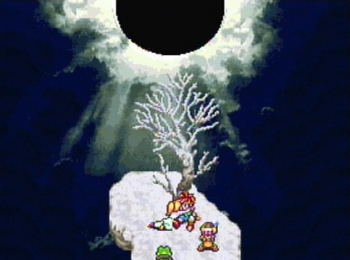
Despite the limitations of the SNES hardware and its cartridges, Chrono Trigger manages to create touching and memorable scenes with its sprite-acted cut scenes.
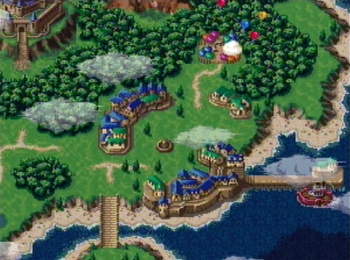
The opening shot of Chrono Trigger shows the Guardia Kingdom in the year 1000. You can see balloons rising out of Leene Square where the Millenium Fair is in full swing.
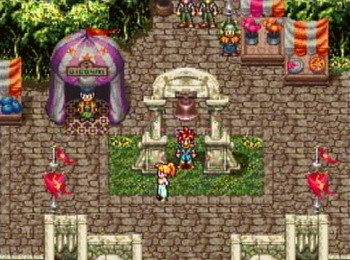
Almost everything in Chrono Trigger comes into play twice (often in different eras.) The fair is no exception. Everything you do gets brought up again later on in the game.
Review by Jay Wilson I prefer games which require an actual gameplay component such as navigating dungeons while fighting Wizzrobes in The Legend of Zelda, shooting down Swirls in Yar’s Revenge, space jumping through Norfair’s fiery lava fountains in Super Metroid, or parrying Akuma’s fireball onslaught in Street Fighter III: Third Strike—all of which feel like I’m accomplishing something. Like I’m beating something in real time. Role Playing Games always struck me as pseudo-accounting where instead of requiring any skill it instead rewards wandering around a cubicle while banging your head on the filing cabinet until enough XP and treasure pop out and renders the problems moot. Which brings me to Chrono Trigger. I adore CT for its simplicity. It saves me the time and trouble of micromanaging stats, spells, and inventory. Seven playable characters with a maximum party size of three translates to minimal upkeep. And while certain sequences of the game require a certain character in the party for story-related purposes, these are kept to a minimum; and at no time does the game force multiple parties upon me. In other words, I can develop my core team of Crono, Marle, and Frog and not have to screw with Ayla, Lucca, and Robo. Furthermore, every character’s Spells, Techniques, and Combination Attacks are set in stone from the get go. This means, if I want to make Haste available to my party, I have to bring Marle; if I want to use Charm, I need to make room for Ayla; and if I want to unleash X-Strike, then I need both Crono and Frog. Uzi-punch? Call in Robo! Simple as that. One could point out this limits your options as a player, but, you know what? If it keeps me out of that God-forsaken stat screen and lets me actually get more play time, then good riddance to materia, runes, espers, drawing spells, and whatever the hell else also passes for gameplay in this genre. It’s as though CT is aware that scrolling through menus and selecting your most damaging attack repeatedly doesn’t qualify as gaming, so it does what it can by offering an Active Battle Mode where enemies don’t stand idle while you leisurely sift through your options. This adds some intensity when Zeal casts Hallation, bringing the entire party to the brink of death. And to make matters worse, I know a follow up is on the way to finish everyone off. It also mercifully ditches random battles prevalent in mid-90s RPGs in favor of on-screen enemies. You see, other games such as Final Fantasy VI had a map or exploration screen where you navigate your characters around the environment. Enemies almost never appear on this screen, however out of the blue the game would jump to a battle screen and half a dozen enemies would materialize out of thin air. There’s no way to avoid random battles; it’s like every creature in the world—even glorified amoebas—has the magic ability to sneak up and surround you, springing a surprise attack at their leisure. At best, you can run away and trigger another random battle with your next half-step. And let me just say, you don’t know the definition of annoying until you’ve fought twelve unavoidable battles trying to get to the save point three feet away. In Chrono Trigger? The enemies are on the map. You can see them. If you just want to get from point A to point B because you have to go to work in five minutes, you can just walk around the enemies. And you know what? The world feels more cohesive and consistent—more believable—not having to jump back and forth between the battle screen and the environment all the time. 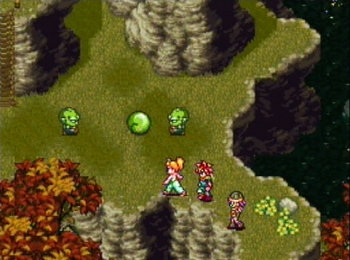
Being able to walk around enemies who can plainly see you might not be more realistic than random battles, but it sure is infinitely less irritating.
On that note, Chrono Trigger uses one set of large, colorful, stylized, and articulate sprites to tell the story, allow the player to explore the world, and battle monsters. Furthermore, these same sprites inform the player of negative status effects on the party members, and they define the personalities of the character with an array of emotes—spoiled Marle has a temper-tantrum scream; Robo, a mechanical man from the future, can open up and release exhaust; Frog has that vocal sac “bubble” in his throat that rapidly inflates and deflates. Even how they run around as they follow Crono is character dependant—Marle has a very girlish run, Frog hops around, Ayla runs on all fours like saber-tooth tiger. By contrast, in a game such as Final Fantasy VI a boss would appear as a sprite in the environment to deliver dialog, and upon entering the (separate) battle screen their sprite would change to a highly detailed (but woefully inarticulate) portrait-like graphic. Even the mighty Final Fantasy VII with its groundbreaking 3D would ditch the low res exploration polygon models for more detailed battle screen models. The battle screen and random battles, of course, are a relics from the NES era where it actually helped the game’s presentation get around the limitations of the 8-bit hardware. But for the 16-bit SNES and beyond, it felt jarring jumping from a non-threatening environment with no enemies in sight to a generic battle screen surrounded by enemies and bosses with sudden graphical updates. It’s kinda like that moment when watching a cheesy movie where you realize the characters don’t notice something right in front of them ... and then you spot the badly mismatched stunt double. Chrono Trigger has one set of sprites. You battle the evil general Ozzie in the exact same room where you just exchanged words. No battle screen. No stunt doubles. Consistent. Cohesive. 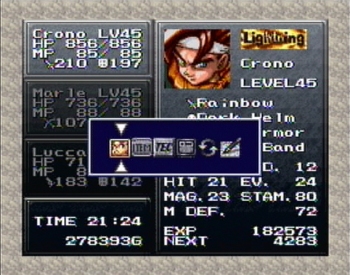
I will never ever understand people who pay good money to spend obscene amounts of time in screens like this, micromanaging a group of fictional people.

The End of Time serves as a hub for travelling to other points in the timeline and also provides a logical place for characters not in the party to stay until needed.

Only four options in battle: Attack, Technique / Combination, and Items. To run away, hold both shoulder buttons (L&R). Simple. Streamlined. Effective.
As the story advances leading to the inevitable boss fights, Trigger goes out of its way to give these battles strategic elements so there’s some sense of genuine exploration and discovery while essentially selecting options from a menu. Some bosses are vulnerable to certain attacks, others will fiercely retaliate if you don’t take down their targets in the right order, while others still are only vulnerable during certain times, and one of the last bosses constantly drops your party to 1hp forcing you to figure out just how much healing you need to survive the subsequent attacks but not waste precious resources getting back up to full health only to drop back to near death. When you know all the tricks and attack patterns, Chrono Trigger becomes just another menu-spam fest, but at least it has that first time when you go into each battle cold and start systematically trying stuff, hoping to identify the components and proper weak points before their defenses shut you out of the fight. And the game leaves room for you to make these mistakes and still survive the battle (albeit, it becomes harder and harder as the game progresses) so you could, theoretically, step into any fight blind and come out victorious which caters to my preference of non-grinding in the moment play. But what really draws me to Chrono Trigger is its narrative and characters. It taps into the spirit of childhood memories and fairy tales. The game opens with the protagonist, Crono, getting dragged out of bed by his mom, a cat follows him around in his house, and before the mechanics of an RPG can kick in, the player gets invited to play mini-games at the Millenium Fair. What child hasn’t been dragged out of bed by his parent? What kid hasn’t ran around a fair, circus, amusement park, or birthday party? What kid hasn’t been attracted to a tent of horrors (or R-rated movie, or freak show?) So from the get go, Chrono Trigger provides an atmosphere that radiates childhood joy, fun, and most importantly: innocence. Innocence. When we’re young, we tend to believe whatever we’re told. And why not? We survive those early years because someone takes care of us. If they go out of their way keeping us alive and healthy, why would they do something so minor as lie? But people do lie, and inevitably someone reveals those lies to us. Then, over time, as we discover more and more lies, we grow to regard the people who see through these deceptions as sophisticated, and we naturally want to emulate those people. We don’t want to be like those unenlightened individuals who blindly believe everything they hear. You know, children. Thus, trust turns to skepticism. We start to doubt, we want proof, and we start looking for reasons—excuses, really—to disbelieve. Someone tells us a story, and we automatically search for something unrealistic to point out because we’re adults and that’s what adults do. However, by channeling the spirit of childhood—the innocence—Chrono Trigger disarms our disbelief. It invites us to become that little boy or little girl lying in bed again, listening to our parents read in reverent tones as we slowly drift into the realm of dreams. It makes us want to believe. And from these childhood memories, Chrono Trigger moves on to fairy tales, going so far as having Nadia (a Princess) kiss Glenn (a Frog). The main trio of protagonists, Crono, Lucca, and Marle are very young, not unlike pretty much any Fairy Tale. They live in a place called Guardia Kingdom which is holding a fair to celebrate the year 1000—a ripe setting for a storybookesque tale. And in the first quest, Crono has to save Princess Nadia but not from a tower. Rather, from non-existence. Through an accident involving Lucca’s new invention, Nadia gets sucked into a time warp and ends up in the past where her ancestor has been kidnapped. Nadia’s presence in the past, however, causes an identity mix up, and the people mistake Nadia for Queen Leene from which the present timeline’s Leene Square gets its named. With no one to save the real Queen, Nadia cannot exist. Now it’s up to Crono and Lucca to rescue Leene and, by extension, Nadia. Thus begins the time travelling fairy tale of Chrono Trigger. 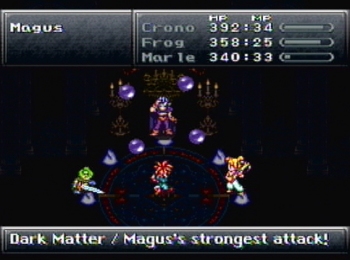
While CT’s bosses often require a specific strategy to beat, the message bar (bottom) prevents the guessing game / needle-in-a-haystack search from becoming a chore.
And it’s through the time travel element that Trigger introduces just enough twists to keep its story from being a total regurgitation of classical premises and archetypes, proving that sometimes one twist and a lot of charm is all you need to sustain a story. Through a series of seemingly unrelated adventures, Crono, Lucca, and Marle eventually end up in a bleak future where the final shards of humanity are dying, and they’ll learn of a large powerful creature called Lavos who rises out of the planet’s core and rains destruction across the globe. The party vows to not let the planet die like this. And from the distant past to the end of time, they’ll search for answers to one day defeat Lavos. And Chrono Trigger does something very clever. Many RPGs allow the player to gradually explore a continent, going from one nation to the next. More epic RPGs allow the exploration of an entire planet one continent at a time. Chrono Trigger gives you the same planet with five eras to explore, each with its own unique palette and distinct sound. The current year, 1,000AD, features the most appealing colors—lush foliage in bright greens and deep blue oceans set against a beautiful and haunting piano melody. The year 600AD maintains the same land masses and kingdoms, but dims the palette as though peering through a layer of fog which feels appropriate with its wandering music. Tribal percussion dominates the soundtrack at 65,000,000BC where reds and yellows fill out the volcanic landscape. Meanwhile, murky browns and lonely woodwinds over ambient wind chimes represents the bleak future year 2,300AD. 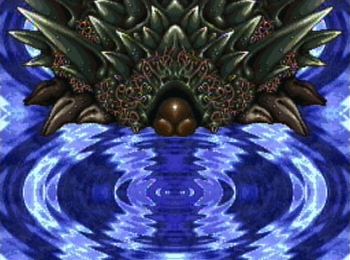
I love that you really don’t know anything about Lavos. Fighting a big unknown thing with no real origin (or end) seems more epic and intense than fighting some maniac with magical powers.

Years later, Chrono Trigger would be re-released on the PS1 with anime cut-scenes, but I feel the SNES’s sprite-acted cut scenes creates a more consistent cohesive world which packs more punch.
And as you progress through the game, the effects of one event ripples into the future. For example, in the year 1,0000AD animosity exists between humanity and a race known as mystics, but travel back to the year 600AD and defeat the divisive leaders, and the two races will live in harmony. Likewise, a forest can bloom from a desert with the right steps, and a malicious NPC in one era can turn into a gentleman by performing an act of generosity to his ancestor. It’s through these touches that Chrono Trigger shows you point blank the progression of ideas and technology, the history which impacts the geography, and how one generation affects the generations that succeed it which makes the death of the planet all the more tragic. In most other end of the world stories, the narrative focuses exclusively on the current generation that will perish. But Chrono Trigger goes even further by showing we, as a collective, have worked since the beginning of time towards something. I think deep inside our subconscious death, itself, really doesn’t bother us. We know it’ll happen. But before we die, we want our lives to mean something. Chrono Trigger takes that feeling and magnifies it not just to a global scale, but to a scale that encompasses all of time. If Lavos rises, everything that was and everything that will be ... ... it was all for nothing. | ||||||||||||||||||||
|
| ||||||||||||||||||||
